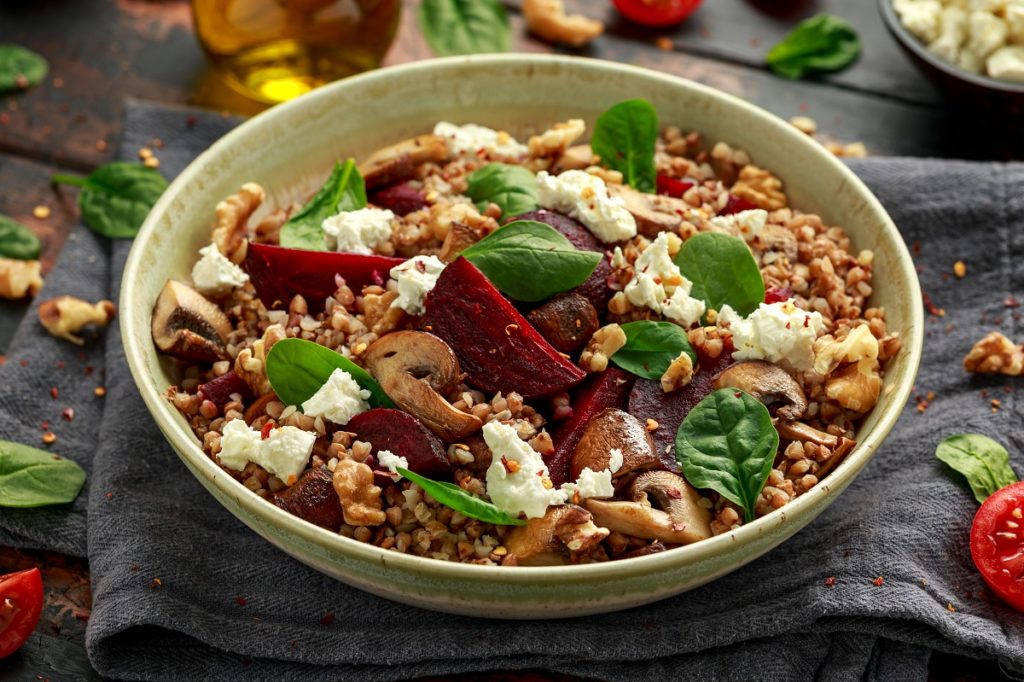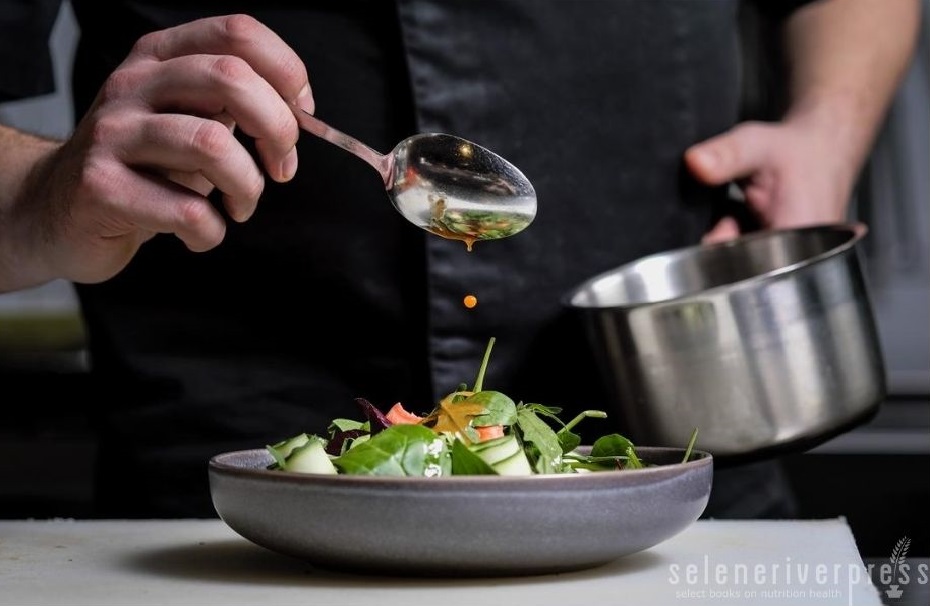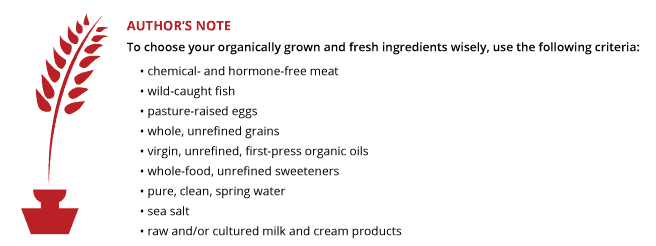I recently attempted to accomplish two of my summer cooking goals: 1) keep a cool kitchen and 2) reduce food preparation time. To this end, I decided that would eat a light breakfast. For lunch, I would have a handful of crispy nuts (which you can learn about in my Cook Your Way to Wellness DVD and booklet). And for my evening meal, I would make a large bowl of mixed greens, throw in some cold beef, chicken, or salmon, and, last but not least, add a homemade salad dressing (which I chose from the list of four salad dressings near the end of this post).
Sounds yummy, right? Well, just wait till you read the rest of my salad bonanza story.
After consuming piping hot soups (my favorite being my own bean soup) as well as other warm favorites over the long, cold winter months, it was a sincere pleasure to load up on fresh organic greens. It was sooo good that I ate the same light breakfast, crispy nut snack, and evening salad for five days straight, and I never once had a thought that I was heading for a huge disaster! However, a week into my well-thought-out salad bonanza, I began to feel severe cramping in my lower abdomen, accompanied with lower back pain and some very serious constipation.
I immediately went to see my chiropractor, and he found that I had a colon issue, described as either a swollen or inflamed colon. He tested me for the best Standard Process supplement to address the issue, which turned out to be Okra Pepsin E3 as it helps with bowel cleansing and function.
Once home, I headed to my many health books and also went online to do some serious research on how eating (or overeating) too many raw veggies and greens effects the colon. I also began adding a small amount of cooked grains to my salads and some of my other favorite dishes. Soon enough, I was on my way to feeling better.
What’s the moral of this story? Was it the salads? Below are a few words of wisdom I gleaned from my research. Take them to heart—as I can tell you that an inflamed colon is bad news!
Abrupt Changes in Your Eating Habits Can Make You Sick
Indeed, suddenly switching to a healthy diet can turn out to have some unwanted side effects, such as intestinal gas, stomach bloating and cramping.
These are the exact symptoms I experienced after a week of eating only salad for dinner. I found numerous other articles that warn against eating too many uncooked vegetables, especially if they aren’t your normal daily fare. Uncooked greens and other raw vegetables are much harder for the digestive system to break down because of the higher fiber content. Although I’ve always included normal-sized salads in my diet, I’ve never excluded all other foods for any length of time or eaten so much salad at one sitting.
As I contemplated this experience, it occurred to me that I made this drastic change to my diet without considering the best way to include occasional healthy salads as a meal. To that end, I did a little more research, and I learned that it’s possible to eat healthy salads without causing havoc in our digestive system. So please read on.
Making Your Next Meal a Healthy Salad
Many people think of a salad as green lettuce with a ton of salad dressing. In my case, it was various raw greens and veggies such as cucumbers, tomatoes, onions, and mushrooms. The big mistake I made was that this was pretty much all I was eating. To add to this dietary disaster, I ate only salads for over a week!
However, a healthy salad can include so much more than cooked or raw veggies and fresh greens. You can add cheese, meat, seafood, a hard-boiled or soft-boiled egg—you name it.
What was most intriguing to me is learning that cooked whole grains can be another healthy addition that enhances this nutrient dense meal. In other words, you can make a healthy meal out of salads and use them as a substitute for regular day-to-day meals that would otherwise grace your dinner table. Just don’t make it all you eat for a week! (Smile)
Five Healthy Whole Grains to Add to Your Next Salad
Whole grains provide a nutrient dense punch to any salad. (However, all grains should be properly prepared by soaking overnight with about a tablespoon of vinegar, lemon juice, or whey.) Before you begin to use whole grains, I suggest reading “Should We Eat Grains (Principle #6)” by Sally Fallon Morrell. If you haven’t been able to eat grains, you may learn why and what you need to do to change it.
Six Perfect Whole Grain Berries for Your Next Grain Salad
*Personal note: Before using quinoa, please read this blog post by Monica Corrado.
For inspiration on making your own healthy salads with the grains above, read “25 Great Grain Salad Recipes” from Taste of Home.
Treasured Homemade Salad Dressings
Following are some of Megan’s wonderful salad dressings. Megan is the leader of the Denver chapter of the Weston A. Price Foundation.
Simple Salad Dressing
Ingredients
¾ cup extra virgin olive oil
¼ cup raw apple cider vinegar
2 cloves finely chopped garlic
1 tablespoon dried parsley
2 teaspoons sea salt
½ teaspoon prepared Dijon mustard
1 tablespoon honey (optional)
Basic Balsamic Dressing
Ingredients
¾ cup extra virgin olive oil
¼ cup balsamic vinegar
2 cloves finely chopped garlic
1 tablespoon dried parsley
2 teaspoons sea salt
½ teaspoon prepared Dijon mustard
1 tablespoon real maple syrup (optional)
Italian Salad Dressing
Ingredients
¾ cup extra virgin olive oil
¼ cup white or red wine vinegar
2 tablespoons grated Parmesan or Romano cheese
1 tablespoon diced red pepper (optional)
1 teaspoon each dried parsley, basil, oregano, garlic, and onion
2 teaspoons honey
2 teaspoons sea salt or to taste
¼ teaspoon ground black pepper
Ranch Dressing
Ingredients
3 tablespoons mayonnaise
3 tablespoons buttermilk
2 tablespoons sour cream
1 teaspoon champagne or coconut vinegar or lemon juice
1 clove garlic, pressed or finely minced
1 tablespoon each chopped chives and parsley
1 teaspoon kosher salt
½ teaspoon freshly ground black pepper
½ teaspoon dried dill
¼ teaspoon onion powder
Pinch of cayenne pepper
Afterthoughts from the Traditional Cook
A fun project for the children that will help them learn to love vegetables:
- As a whole group, ask students to generate a list of vegetables. Chart how many children have tasted each one. Discuss how different types of vegetables grow (roots, leaves, fruits, flowers, tubers) and why these foods are essential for health. Feel the surface textures and colors of several samples such as squash, eggplant, and broccoli. During the discussion, listen for descriptive words (hot, crunchy, smelly, squishy, prickly).
- Students cover a table with recycled newspapers. On construction paper, students paint a large vegetable with Crayola Washable Paints and Brushes. Mix colors to make it as realistic as possible. Dry overnight.
- Invite students to add details with a Crayola Washable Marker. Show texture and layering, such as the little roots and rings around a carrot, or the layers of an onion’s skin. Encourage students to use their imaginations to bring out the vegetable’s personality with eyes, nose, and mouth. Cut out your vegetable with Crayola Scissors.
- Jot down descriptive words about your vegetable’s personality, including adjectives from the class discussion.
- Students compose poems about their vegetables. Display the poetry with the vegetables for Simply Salad Poems.
—“Simply Salad Poems” lesson plan from CreatED, Professional Learning by Crayola
Disclaimer from Maria Atwood, CNHP: I am a Certified Natural Health Professional, CNHP, not a medical doctor. I do not diagnose, prescribe for, treat, or claim to prevent, mitigate, or cure any human diseases. Please see your medical doctor or health practitioner prior to following any recommendations I make in my blog posts or on my website.
Images from iStock/Mikhail Spaskov (main), Di_Media (Buddha bowl), DronG (grain salad).





